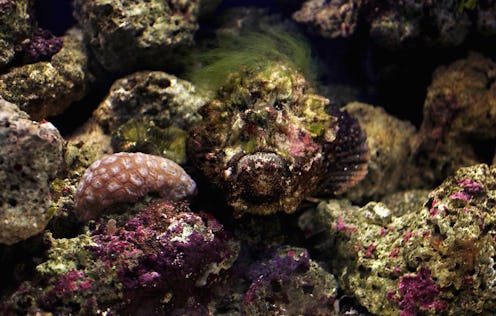Life
Strange Animal Cures For Human Ailments

I'm fascinated by the history of medicine — particularly when it gets gory, gross and preferably involves random animal parts. Everything from ground-up vulture brains up the nose (a medieval European cure for migraine) to wolf's testicles in oil (an Occitan idea for a woman who had "too much desire", to be rubbed on her genitals) pops up if you delve deep enough, and the weirder and more faintly confusing the better. However, modern medicine, with all its wonders, occasionally delivers the sorts of potential cures that may not have looked out of place in a 14th century medical manual. Fish venom to help the immune system? Crab blood to stop the progression of disease? Come off it.
As those previous (and, might I add, discredited) cures attest, we've often looked to the animal kingdom to help us out with our human medical needs, and in some cases it seems as if that was a good idea. Not only that, scientists are increasingly looking to the least benign animals, those in possession of venoms and toxins any sensible person would avoid like the plague, to give us clues about pain relief, the immune system, and other aspects of human health. Nobody said working at the forefront of science was boring.
Cone Snail Venom May Work For Effective Long-Term Pain Relief
This one's been making headlines this week thanks to some new advances, but we've actually known about the potential painkiller properties of cone snail venom for quite some time; five different experimental substances were extracted from it back in 2014, to the excitement of scientists specializing in pain. The new breakthrough, though, is pretty exciting. It comes from the University of Utah, and apparently involves a venomous substance that can be used as a painkiller in a way that doesn't involve the opioid centers of the brain (those pesky pathways that can cause serious addiction to pain drugs).
The Utah scientists used a particular compound made from cone snail venom with the catchy title RgIA on mice in pain, and saw that the RgIA substance was pretty useful: it targeted the pain in an interesting and, importantly, long-lasting ways. The scientists claim that their particular compound was still showing pain-relief signs 72 hours after it was injected, long after it was supposed to have worked its way through the system. The venom works in the wild through paralysis: cone snails shoot it into their prey to make them completely helpless before devouring them. Modified for human use in the future, the scientists hope, this sort of non-opioid pain relief could be really helpful for people with severe chronic pain, without the problem of addiction. But that's a long way off.
Horseshoe Crab Blood To Test Vaccines & Medical Equipment
Global medicine has become a lot less deadly since we discovered bacteria and their role in contamination and infection, but that awareness does mean that we require hyper-vigilance when it comes to medical materials of any kind, from equipment to vaccines. And that's where horseshoe crab blood comes in. No, really.
It turns out that the bright blue blood of this particular crab type is extraordinarily sensitive to any contaminants (they can sense a problematic particle that's one part in a trillion), and will coagulate around anything it finds a mere 45 minutes after it comes into contact with it. The coagulation is obvious and provides an immediate stay-or-go test for the material's safety for use, so the blood has been used for a huge swathe of human medical devices and substances. The problem, as you might have guessed, is that harvesting enough blood to supply demand is difficult, particularly when horseshoe crab numbers are falling worldwide. CNN reported back in 2015 that other tests for contamination operating on the same minuscule precision are in development, including liquid crystals. But for the moment, horseshoe crab blood is one of the greatest weapons modern medicine has. Bizarre, isn't it.
Deadly Stonefish Might Have A Future In Transplant Success
As an Australian, there are two animals I am absolutely petrified of: the intensely lethal blue-ringed octopus, which is tiny and cute, and the stonefish, which is, well, not. It's the ugliest fish in the sea (it's evolved to look like a stone covered in weeds so that it can hide effectively to catch prey), and it's also possessed of venom so heinous it causes instant and extraordinary pain. Yep: it won't necessarily kill you, just put you in agony. Charming. However, there may be a bright side to the stonefish's fighting method. Australian researchers (where else) released research in 2015 that indicated it may one day help people who are the recipients of new organ transplants.
The greatest risk in organ transplanting is rejection by the body's immune system. The Australian scientists discovered, somewhat astonishingly, that a protein in stonefish venom is related to a part of the human immune system called perforin. Perforin is a strange thing: it's responsible for something called "pore formation in the cell membranes of target cells," meaning that it attacks diseased cells targeted by the immune system by creating holes, or "pores," in their vital protective membrane. It doesn't kill the cell itself, but it makes pores large enough for other substances to pass through, doing the dirty work. (Think of it as the member of the bank robbery gang that drills the hole in the safe's wall.)
Stonefish venoms have shed light on how this might happen in humans, but perforin activity is also what tends to cause transplant rejection. We're still trying to understand exactly how perforin works, but as brave Australian scientists continue to wrestle with the worst aquatic dinner party guests on Earth, they may also be working towards a solution that stops perforin from going mad in the immune systems of transplant recipients. Bless you, stonefish.